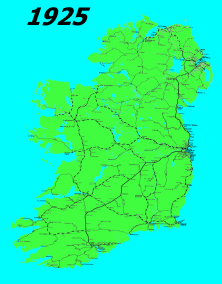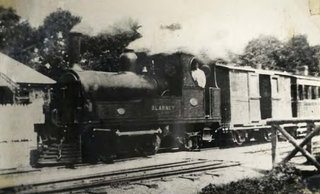Related Research Articles

The history of rail transport in Ireland began only a decade later than that of Great Britain. By its peak in 1920, Ireland had 3,500 route miles (5,630 km). The current status is less than half that amount, with a large unserviced area around the border area between Northern Ireland and The Republic of Ireland.

Blarney is a suburban town within the administrative area of Cork City in Ireland. It is located approximately 8 kilometres (5 mi) north-west of the city centre. It is the site of Blarney Castle, home of the legendary Blarney Stone. Blarney is part of the Dáil constituency of Cork North-Central. It is surrounded by the suburban villages of Tower, Cloghroe and Kerry Pike, all on the outskirts of Cork City.

Coachford is a village in County Cork, Ireland. It is located on the north side of the River Lee. The village is located in the civil parish of Magourney. Coachford is part of the Dáil constituency of Cork North-West.

Cork, Bandon and South Coast Railway (CB&SCR), was an Irish gauge railway in Ireland. It opened in 1849 as the Cork and Bandon Railway (C&BR), changed its name to Cork Bandon and South Coast Railway in 1888 and became part of the Great Southern Railway (GSR) in 1924.

The Tralee and Dingle Light Railway and Tramway was a 32 mi (51 km), 3 ft narrow gauge railway running between Tralee and Dingle, with a 6.2 mi (10.0 km) branch from Castlegregory Junction to Castlegregory, in County Kerry on the west coast of Ireland. It operated between 1891 and 1953; the Castlegregory branch closed shortly prior to the outbreak of the Second World War. It was one of the most westerly railway lines in Europe, but the terminus of the Valentia Harbour branch at 10.277785° was further west.

Tower, Ordnance Survey Ireland name Model Village, is a village within the administrative area of Cork city in Ireland. It is located to the northwest of the city, approximately 3 km from the town of Blarney on the R617 road. Together with Blarney, Tower is a satellite or dormitory town of Cork city. Tower is part of the Dáil constituency of Cork North-Central. As of the 2022 census of Ireland, the village had a population of 3,300.

The Schull and Skibbereen Railway was a minor narrow gauge railway in County Cork, Ireland. It opened in 1886 and closed in 1947. The track gauge was a 3 ft narrow gauge. The formal name of the company was The West Carberry Tramways and Light Railways Company Ltd.

The Cork, Blackrock and Passage Railway (CB&PR) was a 3 ft narrow gauge railway in County Cork, Ireland. The line originally opened in 1850 as a 5 ft 3 in Irish standard gauge railway between Cork and Passage West and operated steam feeder ferries to other locations round Cork Harbour. The company was heavily dependent on summer tourist traffic for a considerable proportion of its revenue. The railway was converted to 3 ft narrow gauge in 1900 in conjunction with extensions southwards to Crosshaven which were completed in 1904. The railway closed in 1932 and has since been replaced by a public pathway and nature area.

The Cork and Muskerry Light Railway was a 3 ft narrow gauge railway in County Cork, Ireland. The first part of the railway opened in 1887 and closed in 1934. A major reason for building the railway was to exploit tourist traffic to Blarney Castle.
The Cork City Railways were constructed in 1911 and opened in 1912 to connect the Irish standard gauge systems north and south of the River Lee in Cork, Ireland.
Cork Western Road railway station was a terminus station on the Cork and Muskerry Light Railway in County Cork, Ireland. The station was located at Lancaster Quay on the Western Road, close to what is now the River Lee Hotel in Cork city.
Victoria railway station was on the Cork and Muskerry Light Railway in County Cork, Ireland.
Carrigrohaine railway station was on the Cork and Muskerry Light Railway in County Cork, Ireland.
Leemount railway station was on the Cork and Muskerry Light Railway in County Cork, Ireland.
Healy's Bridge railway station was on the Cork and Muskerry Light Railway in County Cork, Ireland.
Cloghroe railway station was on the Cork and Muskerry Light Railway in County Cork, Ireland.
St Anne's railway station, also known as St Ann's Hill station, was on the Cork and Muskerry Light Railway in County Cork, Ireland.

Blarney railway station was a terminus station on the Cork and Muskerry Light Railway (CMLR) in County Cork, Ireland. The station served Blarney, and was located on the south side of the town's main square, with Blarney Castle a short walk to the south west.

Kilcrea Castle is a ruined 15th-century towerhouse and bawn located near the Kilcrea Friary, west of Cork City, Ireland. The tower house and friary were both built by Cormac Laidir MacCarthy, 9th Lord of Muskerry.

The River Shournagh, a left tributary of the River Lee, rises some 25 km (16 mi) northwest of the city of Cork in Ireland.
References
- 1 2 Butt, R.V.J. (1995). The Directory of Railway Stations. Patrick Stephens Ltd. p. 232. ISBN 1-85260-508-1.
- ↑ Bell, A, ed. (15 May 1915). "The Cork and Muskerry Light Railway". The Locomotive. XXI (273). Locomotive Publishing Company: 110.
the [Cork and Muskerry Light] railway follows the picturesque valley of the River Shournagh to St Anne's (71⁄4 miles), passing on the way the stations of Healy's Bridge (43⁄4), Coachford Junction (61⁄4), and Tower Bridge (63⁄4 miles from Cork).
- 1 2 Tower & Cloghroe - Collaborative Town Centre Health Check (CTCHC) Report (PDF), Heritage Council, 2023, pp. 5, 6, retrieved 26 August 2024,
The establishment of the Cork and Muskerry Light Railway Line [..] in 1887 connected Tower and Cloghroe via stations at Tower Bridge and St. Ann's Hydro [..] The Cork and Muskerry Light Railway Line closed in 1934 [..] Protected Structures in Tower [..] Tower Bridge [..] The additional square-headed span at the north-west end appears to have been added at a later date to accommodate the Great Southern railway line
- 1 2 Ayres, Bob (2003). "Irish Railway Station Dates" (PDF). Irish Railway Record Society. p. 55.